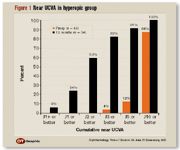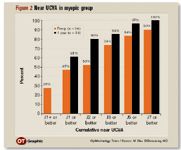Article
Multizone LASIK technique considered safe, effective
Author(s):
Jeddah, Saudi Arabia-Multizone LASIK with peripheral near zone ablation to correct presbyopia together with myopia or hyperopia is safe, effectively corrects spherical error, and improves near vision but without offering a high rate of spectacle independence, according to a study from refractive surgeons here at the Magrabi Hospital.

M. Alaa El Danasoury, MD, reported 1-year results for groups of consecutively treated hyperopic and myopic patients who underwent bilateral LASIK. This technique was introduced by Alain Telandro, MD, Cannes, France.
One-year follow-up was available from 34 (85%) of 40 hyperopic eyes and 36 (72%) of 50 myopic eyes. At 1 year, one (3%) myopic eye showed a best-corrected visual acuity (BCVA) loss of 2 lines, but there were no eyes in the hyperopic group that lost 2 or more lines of BCVA, and contrast sensitivity with and without glare was not changed significantly from baseline.
"One problem with our study is that a significant proportion of the patients treated were younger than 45 years old, and those individuals might have had some residual accommodation," Dr. El Danasoury said. "However, while hyperopic patients were relatively more satisfied than myopic patients, about half of the patients were dissatisfied because they could not get rid of their reading glasses."
A multifocal cornea

All patients in the study were treated by a single surgeon between September 2003 and February 2004 and were considered good candidates for bilateral LASIK. To be eligible for the multifocal protocol, they needed to have a manifest refractive spherical equivalent between –6.0 and +4.0 D, refractive cylinder of 2 D or less, distance spectacle-corrected visual acuity of 20/25 or better, and require a near add of 1 D or more to see J1 or better on the Rosenbaum charts. All flap procedures were done using a specific microkeratome (M2, Moria).
The hyperopic patients had a mean age of 50 years and a mean spherical equivalent (SE) of +1.87 D (range, +0.13 to +3.75 D) with a mean near add of +1.94 D (range, +1.00 to +2.50 D). The average age of the myopic population was 46 years and the average SE in this population was –2.87 D (range, –6.60 D to –0.25 D) with a mean near add of +1.67 D (range, +1.00 to +2.50 D). For the entire cohort, patients were aged 40 to 62 years.
Newsletter
Don’t miss out—get Ophthalmology Times updates on the latest clinical advancements and expert interviews, straight to your inbox.




